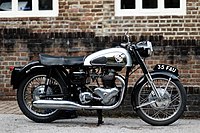
Photo from wikipedia
BACKGROUND Patients with stroke are more likely to be at risk of falling, which lead to limitation in their abilities to perform daily living activities and participation in society. Falling… Click to show full abstract
BACKGROUND Patients with stroke are more likely to be at risk of falling, which lead to limitation in their abilities to perform daily living activities and participation in society. Falling is due to an increase in postural sway and a decline in gait ability. Exercise in water helps them to safely and comfortably improve their motor ability by providing low-risk exercise environments. OBJECTIVE This study was conducted to compare the effect of aquatic versus land motor dual task training on balance and gait of patients with chronic stroke. METHODS Fifty patients with chronic stroke of both sexes aging from 45 to 55 years were randomly assigned to aquatic or land group. Both groups received the same motor dual task training either in water or on land for 45 minutes, 3 days a week for six weeks. Measurement of the dynamic balance indices assessed using Biodex Balance System as well as kinematic gait parameters using Biodex Gait Trainer was performed before and after the intervention. RESULTS There was a significant improvement in all outcome variables post treatment compared with that pre-treatment in both groups (P < 0.05). There was a significant improvement in patients who received the motor dual task training in water compared with patients treated on the land in overall stability index (P = 0.02), anteroposterior stability index (P = 0.03), mediolateral stability index (P = 0.002), walking speed (P = 0.01), step length of affected limb (P = 0.03), step length of non-affected limb (P = 0.01), and time of support on the affected limb (P = 0.002). CONCLUSION Aquatic motor dual task training is more effective in improving balance and gait abilities of patients with chronic stroke than land motor dual task training.
Journal Title: NeuroRehabilitation
Year Published: 2019
Link to full text (if available)
Share on Social Media: Sign Up to like & get
recommendations!